25 Aug The Stunning Diversity of Kolkata’s “Faith Walk”
A unique slice of Kolkata showcases the city’s micro-communities as a melting pot of pluralism and inclusiveness
There is no other place like this in India.
For the sheer diversity of faiths and cultures living side by side, proud of their own identities, this historical two-kilometre slice of Kolkata beats everything else that India has to offer. Perhaps only Delhi’s Chandni Chowk comes close, but even that, not really.
The localities around Bow Barracks and Tiretta Bazaar were originally part of Kolkata’s “grey town”. This was the blended in-between place, where the stately streets of the European “white town” met the crowded, teeming “black town” of the natives. Many different communities settled here to make their fortunes in the rising tide of colonial Kolkata – the Jews, the Chinese, Armenians, Anglo-Indians and Parsis – making it like a woven tapestry of multiculturalism and defining Kolkata for what it is: a generous and accepting city, making space for difference.
Within a short walk of each other, we can visit Parsi fire temples, Jewish synagogues, Chinese temples, Buddhist shrines, a Portuguese church, and Armenian church, all co-existing and functioning. It is among the most remarkable slices of urban landscape in the country.
Start with the easy-going charm of Bow Barracks
The Bow Barracks were built during the First World War for American soldiers stationed in Kolkata. For whatever reason, the soldiers refused to stay here, and the houses were offered to some Anglo-Indian families instead. Since then, this has been the heartbeat of Kolkata’s Anglo-Indian community.
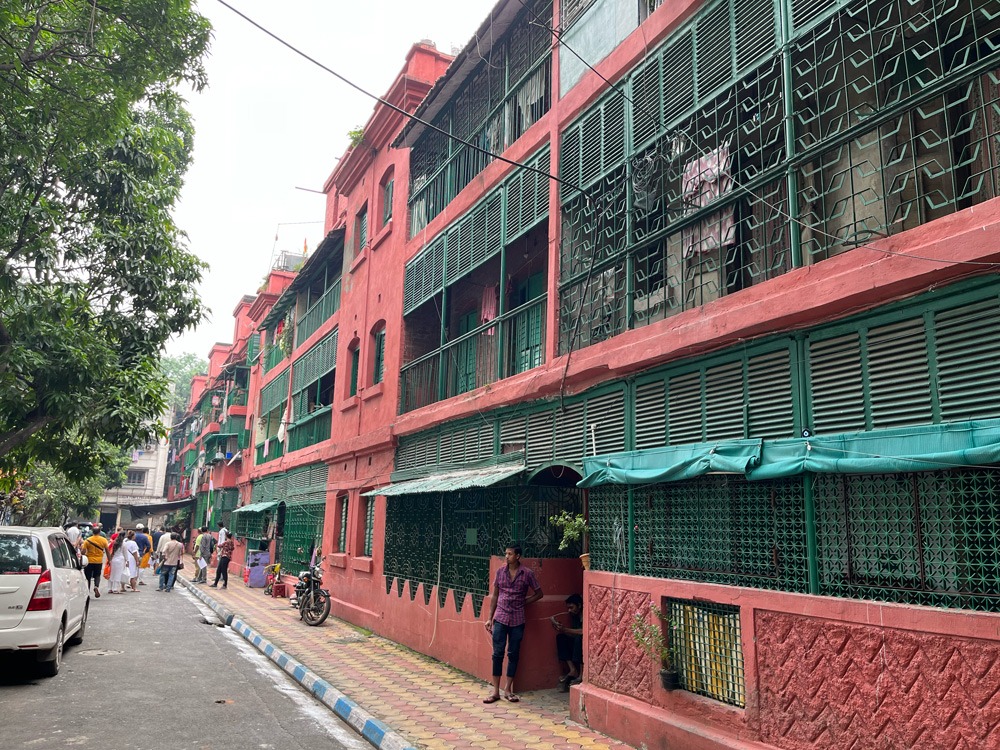
The red-brick facades and green shutters of Bow Barracks are the hub of Kolkata’s Anglo-Indian community
I visited the locality on a Sunday with the atmosphere welcomingly casual and relaxed. There were scenes of domesticity all around me – kids calling out to friends, scooters stopping mid-road for chats, elderly couples looking down from balconies. The voices around me spoke in the sing-song accents of Anglo-Indian English. I heard the thumping notes of Bob Marley’s “No Women, No Cry” blare out from a flat.
The Anglo-Indian community emerged during British rule as the descendants of British settlers and Indian locals. They have a distinct identity, blending both cultures and are deeply intertwined with the city’s colonial past. During the British era, Anglo-Indians played a big role in the civil services (customs, police) and especially the railways. They were the backbone that built the railways into the national asset it is today, as the engine drivers, station masters, foremen and guards who maintained and operated one of the world’s largest rail networks.
At Independence, the Anglo-Indians were given special representation in parliament, with two seats in the Lok Sabha reserved for them (a system discontinued in 2020). However, the Anglo-Indian population has seen a steady exodus through immigration, and mixed marriages are also slowly absorbing the community into the greater Indian mass. Barry O’Brien, in his book on the Anglo-Indians, estimates about 400,000 still living in India, a linguistic and cultural minority with its own way of life, “a community that continues to sparkle in the wonderful mosaic that is India”.
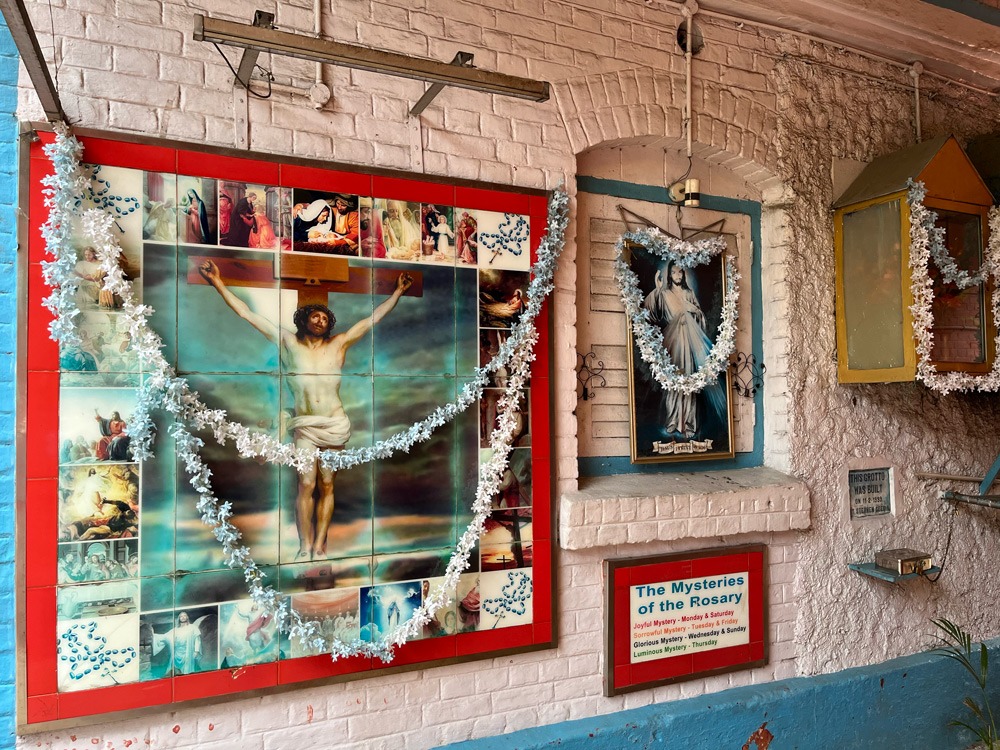
An unmistakably Anglo-Indian neighbourhood; Faith and Prayer at Bow Barracks
Strolling around the area for its sights and sounds, I noticed that – in the spirit of plurality for which this part of Kolkata is known – Bow Barracks was flanked by a Buddhist Temple on one end and the “Manekjee Rustomjee Dharmshala for Parsi Travellers” on the other. A short walk away, down the narrow Metcalfe Street, was Kolkata’s only practising Parsi Agiary.
The Dhunjeebhoy Byramjee Mehta fire temple is Kolkata’s only practising agiary
The Parsis started settling in Kolkata in the late 1700s, drawn – like the Jews, the Armenians, and other mercantile communities – by the commercial opportunities available under British rule. The first Parsis to come were generally wealthy Bombay merchants using Kolkata as a springboard for trade to ports further east, especially the “China trade”, a euphemism for the then-booming business in opium.1
The Dhunjeebhoy Byramjee Mehta fire temple – the only practising Zoroastrian fire temple in Kolkata – was built by R.D. Mehta in memory of his father, who arrived in the city in 1846. The Mehtas were respected public citizens who owned cotton mills and jute mills, and R.D. Mehta himself was a prominent figure in his time – a member of the Asiatic Society, and involved with the early nationalist movement with the Indian National Congress.
Coincidentally, the day I visited the fire temple was a day before the Parsi New Year. Ladies and gents wearing traditional saris and duglis had gathered in the hall, from where a wide flight of stairs led to the fire temple on the first floor. I could hear bells pealing. Wooden boards on the walls displayed the names of past trustees in broad golden letters, and an old grandfather clock – “specially made for R.D. Mehta by J&T Foster of Manchester” – stood with its hands frozen at ten past eight.
There was a kitchen where food was being cooked, the smells wafting across the hall. Stainless steel vessels neatly lined the kitchen shelves. Above was an apartment – I’m guessing for the priest – with twinkling diyas on its balcony. An old-style pulley was attached to its roof, probably used in earlier days to haul up food and supplies.
This was Kolkata’s only functioning agiary, but it is not the oldest. That honour belongs to the now-defunct Banaji Agiary a little distance away. Not many know of this older fire temple, and even though it is now shuttered and encroached upon by electronic hawkers it is full of atmosphere and charisma and is well worth a visit.
To get to Kolkata’s earliest fire temple, I ducked through a barely discernible gap in a line of electric shops on Ezra Street. Shopkeepers knew of this Parsi Dharmic Sthan and showed me the way. Sadly, what was once a vital centre of Parsi community life was now in complete disrepair.
The Banaji Agiary was constructed by Rustomji Cowasji Banaji, a man who was instrumental in helping the Parsi community put down permanent roots in the city. Previously, Parsi merchants would travel to Kolkata for commerce and then retire back to Bombay. It was Banaji who brought his family to Kolkata and encouraged other merchants to do the same. When he opened this agiary in 1839, it was the city’s first fire temple, and he had invited a bevy of luminaries to the inauguration including Dwarkanath Tagore.
The building was now decrepit with crumbling Doric columns and broken wrought iron railings. Pigeons fluttered across its slatted French windows. Kolkata’s first agiary was slowly falling to pieces, surrounded by litigation and apathy yet somehow maintaining its aura. I suggest you go and see it before it is too late.
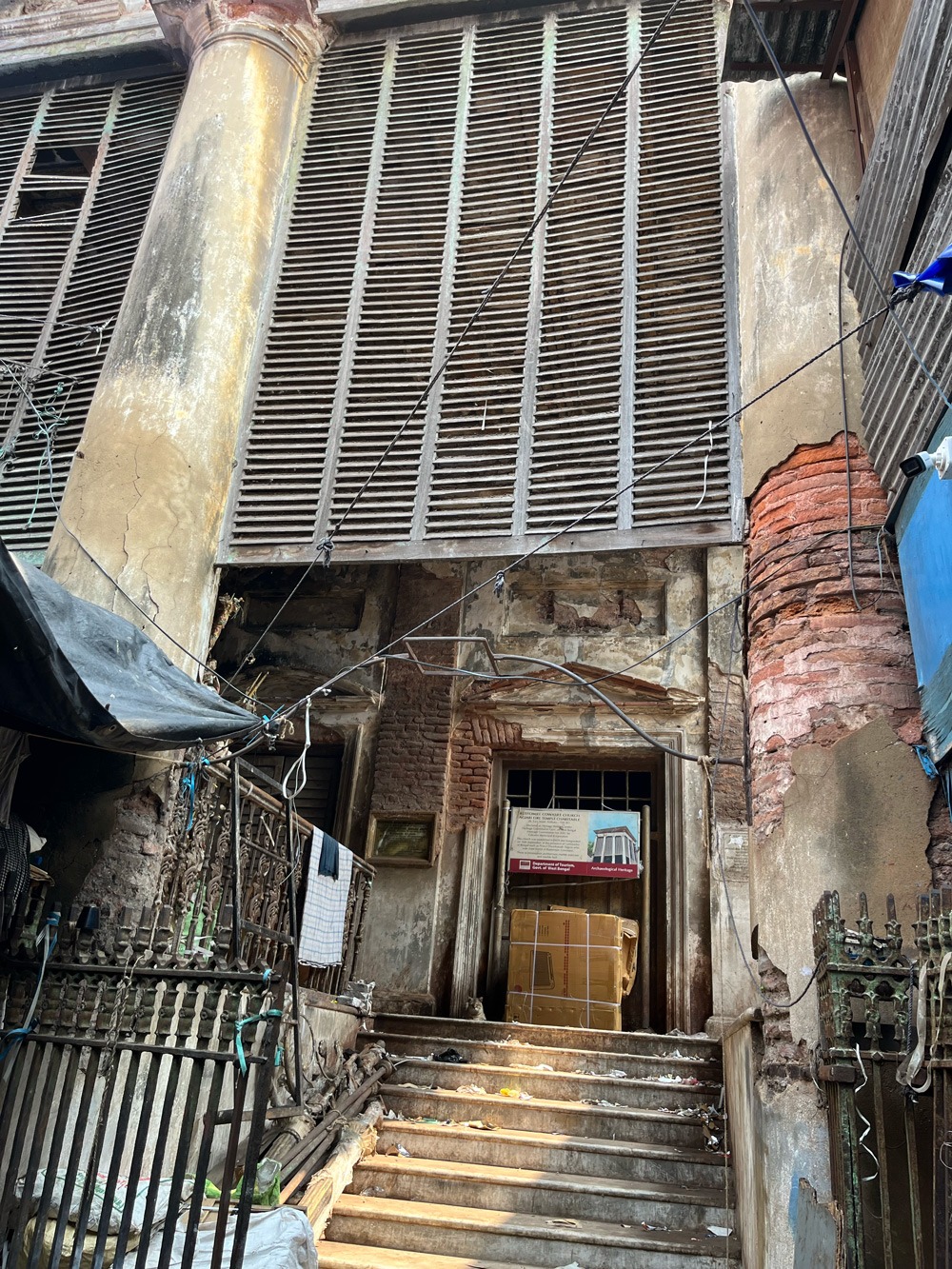 The charismatic ruins of the Banaji Agiary on Ezra Road, the city’s oldest fire temple
The charismatic ruins of the Banaji Agiary on Ezra Road, the city’s oldest fire templeTeritta Bazaar is home to Kolkata’s earliest Chinatown
Adjoining the Parsi agiary is Tiretta Bazaar, home to Kolkata’s earliest Chinese community.
One of the first Chinese to arrive here was a gentleman named Tong Achew, who was granted land by Governor-General Warren Hastings near Budge Budge, a few kilometres from Kolkata, where he began a sugar cane plantation (I visited Achew’s riverside grave, which still exists at Achipur, a village named after him) . This started the nucleus of a Chinese community that migrated to work for him, and gradually they made their way to Kolkata, settling at Teritta Bazaar and making this Kolkata’s first Chinatown. The Chinese found work in the docks and as carpenters, tanners, shoemakers, and owners of opium dens, which were legal at the time.
The streets of Tiretta Bazaar were buzzing and frantic. Carts sold dumplings, fluffy baos and Chinese bread. Shallow drums had live fish in them, which customers poured into their own vessels, the attendants cutting and descaling the fish to their liking. Shops were lined with bottles of sauces – oyster, black bean, and sweet and sour. I ordered a plate of chicken dumplings and chomped away.
There are several Chinese temples here of which the Sea Ip Temple is the main one. Its entrance was painted in bright red Chinese letters, making it stand out from the shops surrounding it. I climbed the temple’s wooden stairs to the first floor, following the smell of incense that filled the air. Worshippers were burning red-coloured candles as offerings to the deity. Each time the offerings were made, and hands folded in prayer, an elderly caretaker struck a bell and a drum, three times each – the shrill sounds of the bell, followed by the deep booming bass of the drum.
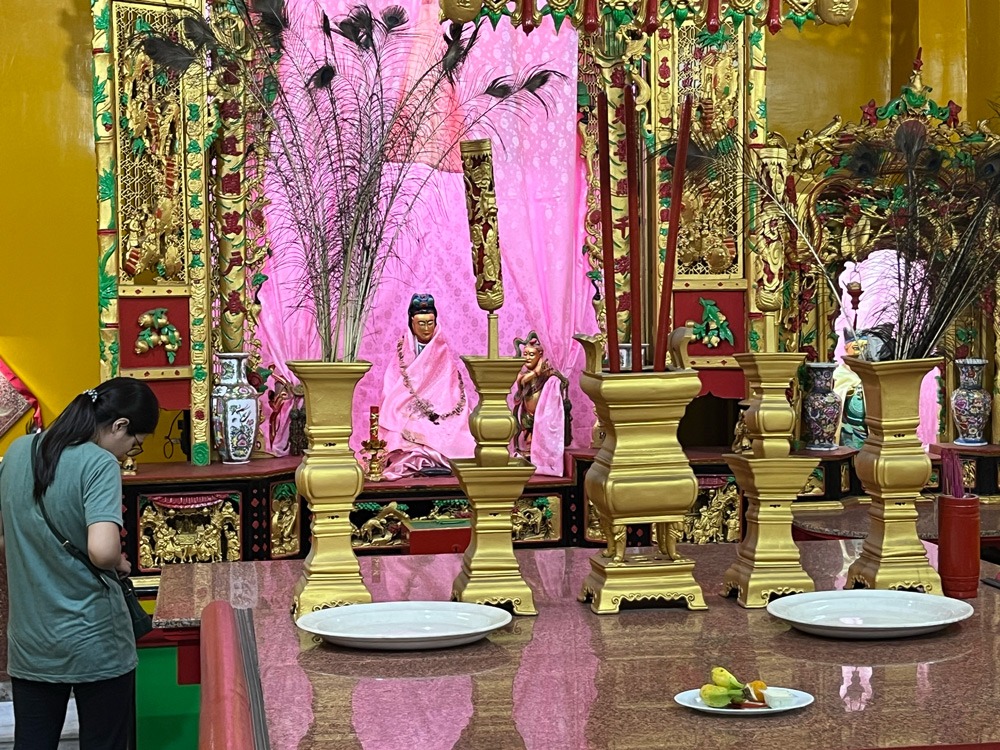 Offerings of candles, bananas and sweets at the Sea Ip temple in Teritta Bazaar’s Chinatown
Offerings of candles, bananas and sweets at the Sea Ip temple in Teritta Bazaar’s ChinatownI had a chance to chat with the aged caretaker, now in his seventies. He mentioned that the Sea Ip Church was built in 1905, that the Chinese who settled at Tiretta Bazaar were Cantonese – unlike those in Tangra, who were Hakka – and that at one stage, there were about 20,000 ethnic Chinese in Kolkata, but the community’s size has decreased to a bare 2000 now. He spoke fluent Bengali and Hindi.
The Baghdadi Jews and their magnificent synagogues
The Jews that settled in Kolkata were Baghdadi Jews, who are different from the other Jewish communities that settled on India’s west coast. They were businesspeople and traders who originated from Iraq but were also from other parts of the Arab world, like Syria and Yemen.
What made Baghdadi Jews unique was that they were part of a “connected diaspora” living in small communities between Bombay, Kolkata, Rangoon, Singapore, Hong Kong, and Shanghai. They worked with each other across these port cities, intermarrying and doing business. Kolkata was a shining star of this connected network.
Even at their peak there were only about 4000 Jews in Kolkata, but sadly, as with the city’s other micro-communities, their numbers have dwindled to a handful now. Some became major business barons, and they have left us a treasure of built heritage, like the Esplanade Mansions and Chowringhee Mansions (both built by the Ezra family, in their day the largest property owners in Kolkata, and after whom Ezra Street is named), schools, a Jewish cemetery (in which is buried Abraham Shalom Yosef, 1833-1911, who donated the funds for Jerusalem’s and Hebron’s first hospitals)2, and three impressive synagogues – the Neveh Shalome, the Beth El, and the Maghen David, all clustered close together.
The synagogues are in great condition and maintained by Jewish Trust Funds. They have recently gathered much media attention, both for the splendour of their architecture as well as the fact that for generations, they have been served by Muslim caretakers, something that seems amazing to a polarised world but is taken for granted in the cultural diversity of Kolkata. For the Baghdadi Jews, with their roots in the Mideast and familiarity with the Islamic faith, there seemed no contradiction in having Muslim caretakers.
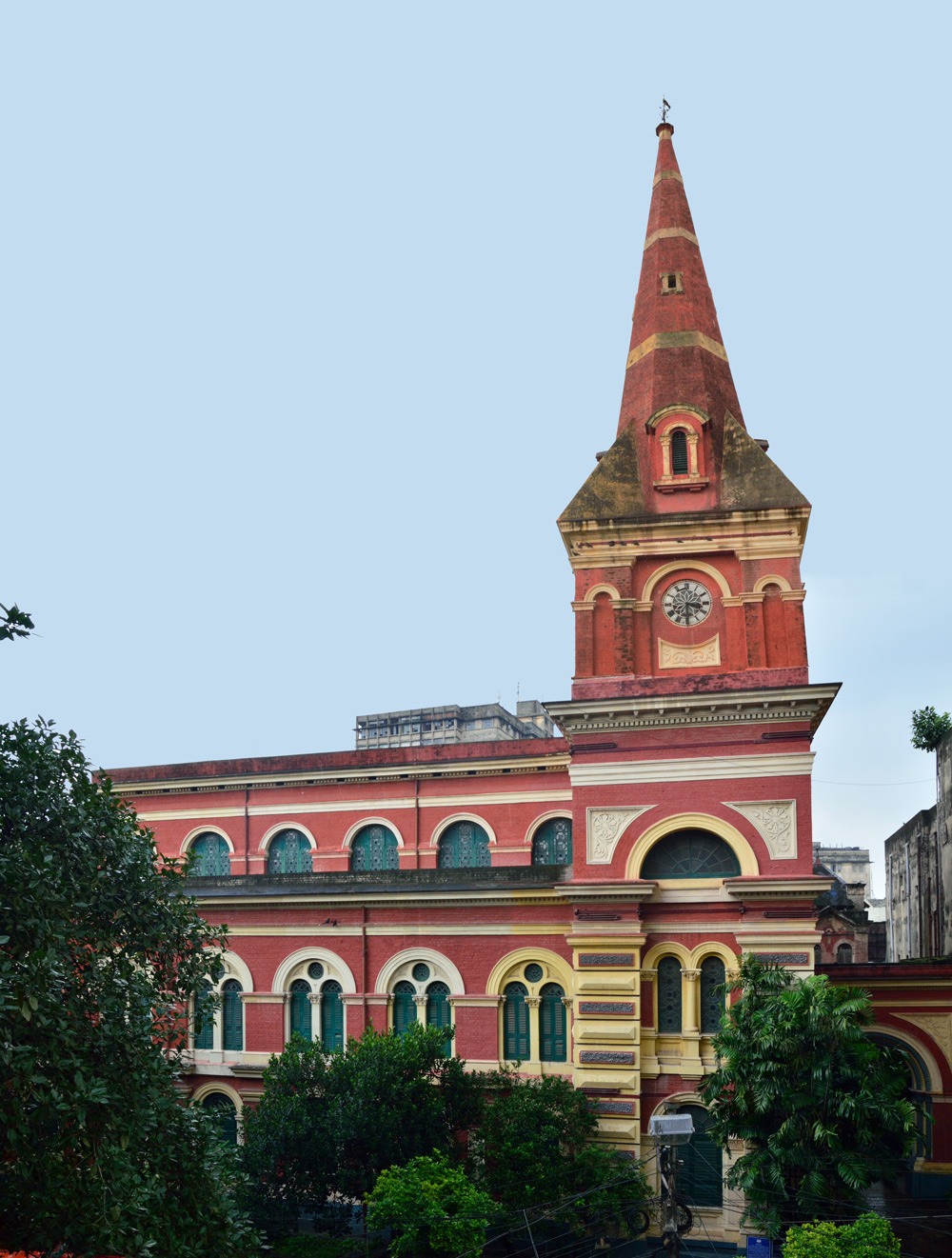 The soaring steeple of Magen David synagogue was built on the condition that it’s taller than its neighbouring churches (picture credit Wikipedia)
The soaring steeple of Magen David synagogue was built on the condition that it’s taller than its neighbouring churches (picture credit Wikipedia) The most majestic of the synagogues is the Magen David (literally Star of David), considered the largest synagogue in Asia and built by the wealthy Ezra family in 1884. Its façade looks more like a church, with a towering steeple and clock face. When it was being built, Kolkata’s Jews sought guidance from Baghdad on whether it was appropriate for a synagogue to have a steeple, and they were given the go-ahead if it was higher than others around it. So, the steeple is 142 feet high and the clock at 64 feet was the largest public clock in the city.
I showed my ID to the caretakers Masood Hussain and Rabbul Khan (both minor celebrities, interviewed by many media channels), who handed me a kippah and showed me around. The synagogues were imposing and ornate. While Magen David is bigger, Beth El is the more elegant and charming. They have similar features – soaring ceilings, checkered black-and-white floors, beautiful stained-glass windows, polished wooden benches, and oil-lamp chandeliers suspended on slender rods.
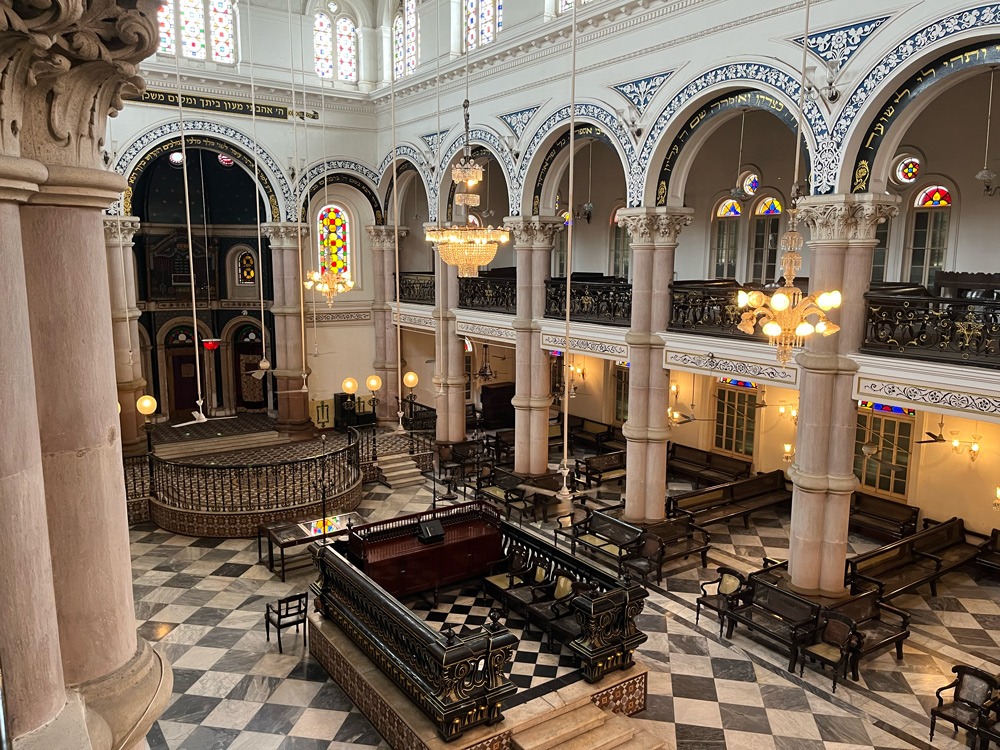 The ornate interiors of Magen David; a women’s gallery upstairs, the Bimah at the centre, and oil-lamp chandeliers
The ornate interiors of Magen David; a women’s gallery upstairs, the Bimah at the centre, and oil-lamp chandeliersIf it’s your first visit to synagogues, there are a few things to look out for. In a nod to the Baghdadi Jews’ Mideast origins, there is a lady’s gallery upstairs of pillared colonnades and wrought-iron balconies from where one gets sweeping views of the main hall. Note also that the synagogue has no idols; instead, it has Jewish motifs like the Star of David and the Menorah – the seven-branched candelabra used in Jewish worship. There is a Bimah – a raised platform in the centre where the Torah is read from. And above the Ark – which is the holiest part of the synagogue where the Torah scroll is kept – the words “Know Before Who You Stand” are written in golden Hebrew letters on a deep blue background.
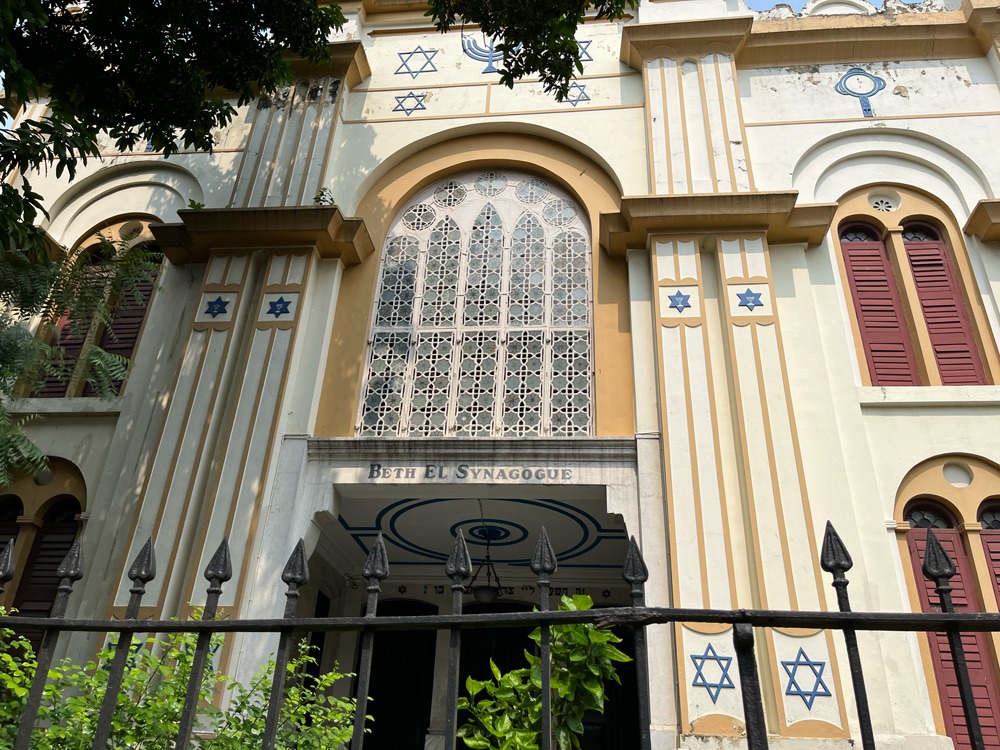 A blue stained glass window towers above the entrance of Beth El
A blue stained glass window towers above the entrance of Beth ElTowards the back of Beth El was a tandoor used earlier for baking the matzah bread for the Passover festival, which was then distributed to Jewish families. And opposite that, in the basement of the building, was a wine cellar where kosher wine was stored. Rows of massive vats, four feet in height and brought all the way from China (a sign of the community’s trade links with that country), silently lined its walls.
Two fine churches: Portuguese and Armenian
The faith walk ends with a visit to two fine churches, both in pristine condition, built by two communities that predate the English in Bengal: the Portuguese and the Armenians.
Kolkata’s only Portuguese church was built in 1799, with funds donated by a rich trader, Joseph Baretto. Just beyond it, down a narrow lane appropriately named Armenian Street, massive wooden gates lead to a courtyard dotted with ancient graves and the sparkling white Armenian church, the city’s oldest church.
The Armenians have been influential in India ever since the reign of Emperor Akbar, who appointed an Armenian, Abdul Hai, as his chief justice and married Armenian Mariam Zamani Begum as one of his wives. Here in Kolkata, not only is the Armenian church the city’s oldest church, but it also has Kolkata’s earliest Christian grave, that of Reezabeebeh Sookias, who died in 1630. This means that several decades before the East India Company’s Job Charnock landed in Sutanuti in 1690 to strike roots for the British, the Armenians were already present.
This could be the reason the British signed a special agreement with Armenians in London in 1688, giving them equal rights with British subjects for the freedom of religion and travel and special trade privileges. The Armenians used these benefits well, creating their own wealth and constructing some of Kolkata’s most storied residences along Park Street: Stephen’s Court, Park Mansions, and Queens Mansions.
Like the other micro-minorities, the Armenians, too, are now less than fifty in the city. But the Armenian College – established over 200 years ago by the Kolkata Armenian community to educate their children – still functions at Free School Street (on premises that were originally the birthplace of the English novelist William Makepeace Thackeray) and provides tuition and lodging to hundreds of Armenian students from Armenia, Iran, and Iraq, keeping alive Armenian heritage and adding to the city’s social fabric and cultural richness.
*1 Chapter on “The Banaji and Mehta Families: Forging the Paris Community in Calcutta” by Dinyar Patel. Page 216
*2 source: Jael Silliman
Information:
- If you’re driving, park near Yogayog Bhawan on Central Avenue, from where it’s a short walk to Bow Barracks.
- A visit to the main attractions will take about 3 hours.
- The best walking route to follow is to start from Bow Barracks –> Metcalfe Street (Parsi Fire Temple) –> Tiretta Bazaar (Chinese temples) –> Ezra Street (old Parsi Fire Temple) –> Brabourne Road (the synagogues).
- It’s best to visit Tiretta Bazaar (old Chinatown) on weekend mornings for its food stalls.
- All the places of worship are open to the public and free to enter. For the synagogues, you could ask the caretakers to open them for you.
Sources:
- “The Banaji and Mehta Families: Forging the Paris community in Calcutta” by Dinyar Patel. Chapter in the book “Holy Wealth: Accounting for This World and the Next in Religious Belief and Practice”, John R Hinnells
- “Imagined Homelands: Baghdadi Jews in South, East and Southeast Asia, and Europe (1850-1950)”, by Marcella Simoni
- “Therein Lies a Tale: The Synagogues of the Baghdadi Jews of Calcutta”, by Jael Silliman
- “The Anglo Indians. A portrait of a community”, by Barry O’ Brien

